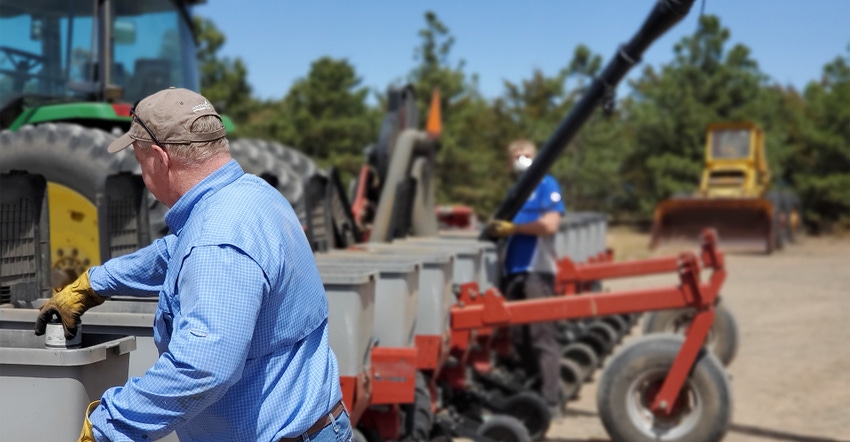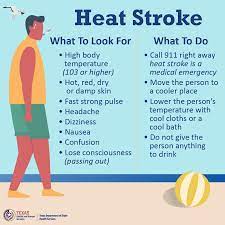June 28, 2021

With the increase in outdoor temperatures also comes an increase in the possibility of heat stress — possibly even heat exhaustion or heatstroke — but there are some steps you can take to help beat the heat, said a Texas A&M AgriLife Extension Service expert.
“Now that we’re getting into summertime temperatures, and people are looking to stay active outdoors, there are a few basic signs and tips to help be aware of the risks for heat-related illness or hyperthermia,” said Mark Faries, AgriLife Extension state health specialist in the agency’s Family and Community Health Unit. “Awareness is important with exposure to a higher heat index or heatwaves, especially for those who might be at higher risk of heat illness.”
 Heatstroke is an extreme type of heat stress. (Texas Department of State Health Service graphic)
Heatstroke is an extreme type of heat stress. (Texas Department of State Health Service graphic)
Faries said those at higher risk include adults 65 years of age or older, infants, children up to 4-5 years of age, and those with existing medical conditions such as diabetes, high blood pressure, heart disease, or obesity.
“However, anyone can succumb to heat with outdoor activity, with added concerns with drinking alcohol, low hydration, and even with some medications,” he said.
Faries said it is vital to know the warning signs of heat stress and how it progresses, as well as what to do in response to different levels of heat-induced illness.
“It’s easy for heat stress to sneak up on us when we are engaged in outdoor activities, so learning ways to ‘beat the heat,’ and protect ourselves from the sun are also important for staying healthy during the summer,” he said.
He said that the body naturally heats up during physical activity but has ways to keep itself cool. However, in cases of extreme heat, the body heats up faster and evaporation of sweat cannot keep up to maintain a normal temperature.
“In such instances, heat illness can lead to death,” Faries said. “But since heat illness is progressive, with awareness of the types, symptoms, and treatments for initial degrees of heat stress, we can catch any risk early.”
Types of and treatments for heat stress
According to the Centers for Disease Control and Prevention, symptoms of heat stress may include headache, thirst, general weakness, increased body temperature, dizziness, loss of appetite, excessive sweating, cramping, fast breathing, and rapid pulse. Here are some of the symptoms and treatments for different levels of heat stress offered by the CDC:
— Heat rash. Heat rash is a skin irritation caused by excessive sweating. It appears as a red cluster of small blisters, usually in the area of the neck, upper chest or groin, as well as under the chest, at the waist and in elbow creases.
People experiencing heat rash should find a cooler, less humid place to treat for it and keep the rash area as dry as possible. It’s a good idea to apply powder to help with the irritation, but it is best to avoid the use of creams or ointments as these add moisture to the rash and may delay healing.
— Heat cramps. These typically occur when a person sweats a good deal during physical activity, causing muscle pains or spasms. The cramping usually occurs in the arms, legs or abdomen.
“Sweating reduces the amount of water and electrolytes in the body, such as sodium, potassium and magnesium, so excessive sweating and physical exertion in the heat can lead to these painful muscle cramps,” Faries said.
To treat muscle cramps, the CDC recommends stopping the activity and relocating to a cooler place. Drink plenty of water or a sports drink with electrolytes to replace lost liquids and refrain from any further activity until the cramps subside. If the cramping lasts for more than an hour or if you are on a low-sodium diet or have heart problems, it’s best to seek immediate medical help.
— Heat exhaustion. Symptoms of heat exhaustion can include weakness, excessive sweating, dizziness, headache, nausea, muscle cramps, a rapid pulse and cold, clammy skin.
In more serious instances, heat exhaustion can also cause vomiting or fainting. To treat for heat exhaustion, relocate the person to a cooler area, loosen their clothing and put a wet cloth or cold compress on key areas of the body, such as the forehead, neck and armpits. If there is vomiting or extreme weakness or the symptoms get worse or last more than an hour, seek medical help.
— Heatstroke — If a person’s body temperature gets above 103 degrees, this can likely lead to heatstroke.
“A person experiencing heatstroke is unable to properly regulate body temperature, as it keeps rising,” Faries said. “Oddly, during heatstroke, the body actually stops sweating. Also, the pulse weakens and the skin becomes flushed and red.”
With heatstroke, the individual may also experience an altered mental state, a racing heart and/or severe nausea or vomiting.
Heatstroke is a medical emergency, and the CDC recommends calling 911 immediately if you or someone else is showing signs of heatstroke. However, until emergency medical assistance arrives, they suggest moving the person to a shaded, cool area and removing any outer clothing the person may be wearing. Cool the individual with cold water or ice. Wet the skin and place cold, wet clothes or compresses on key points, such as the head, neck, armpits and groin. Or soak the person’s clothing with cool water.
These treatment suggestions are not intended to be a substitute for professional medical advice, diagnosis or treatment, Faries said.
“You should always seek the advice of a physician or other qualified health provider if you have questions regarding a medical condition.”
Tips for staying cool, protecting from the sun
— Stay adequately hydrated. It’s important to drink an adequate amount of water if you’re out in the sun, even if you’re not especially thirsty.
“Water replaces the body moisture lost through sweating, and that amount will differ from person to person,” Faries said. “Some experts suggest drinking eight, 8-ounce servings of water per day, but the key is to stay hydrated. Drink water before, during and after your physical activity, even if you are not thirsty, and do not forget to keep a water bottle with you.”
According to the American College of Sports Medicine (ACSM), dehydration might cause as much as a 1% reduction change in your body weight.
— Plan your schedule with the weather in mind. If you watch the weather forecast, and see the following day is going to be a scorcher, you can plan around that.
The ACSM also noted the risk of heat stress and illness are increased when the outdoor temperature is 80 degrees or higher, and humidity is greater than 75%.
“Schedule any outdoor activities or errands for the morning or evening, especially if you expect them to be somewhat taxing or strenuous,” Faries said. “This can mean outdoor shopping, home projects, yardwork or exercise.”
Faries said it is important to continue physical activity even during hot days in order to maintain the habit of exercise.
“Hot weather gives people the opportunity to identify and use cooler local access places for their physical activity, such as an air-conditioned gym or building — or even a shaded trail.”
He also noted people who walk as part of their exercise routine often choose to walk indoors at their local mall during hot days.
“Being able to find alternative locations where you can safely continue with your physical activities will help you maintain the habit of exercise, gain confidence and improve your chances for success in leading a more active lifestyle,” Faries said.
— Stay in an air-conditioned location as much as possible.
“If you do not have air conditioning, go to the local shopping mall, a public library or take advantage of indoor events in your community,” Faries said. “Just spending a few hours in air conditioning can help your body stay cooler, and help you beat the heat.”
— Eat for the heat.
“Eating lighter foods during hot days can keep you from overstimulating your metabolism and keep you from feeling sluggish,” said Odessa Keenan, AgriLife Extension wellness initiatives coordinator for the agency’s Healthy Texas program. “Summer is a good time to eat lighter foods with good moisture content such as salads and fresh fruits. The more and heavier foods you eat, the harder your body has to work to get rid of any excess calories, and that can be especially taxing on a hot day.”
— Learn about community cooling centers. Many communities, especially larger towns or cities, set up cooling centers where residents can go to get out of the sun. Local TV news stations or newspapers will usually have information on where these will be set up. In addition, you can call your local health department or dial 311 if that service is available in your area.
— Wear a cap or hat and sunglasses, use sunscreen and limit your time in the sun.
Limit your time in the sun, especially between 10 a.m. and 2 p.m., and wear light colored, loose clothing that will cover exposed skin, such as lightweight long-sleeve shirts and pants. Wear a cap or broad-brim hat to protect your face, and regularly apply a broad-spectrum sunscreen with an SPF value of 15 or higher. Follow all product directions and warnings, including how much and when you should apply and reapply.
— When possible, park under a tree or in a shaded area. It’s not always possible, but if you can find a shaded place to park it will reduce the amount of direct sun exposure to your vehicle.
Of course, it’s imperative that you never leave a child or animal in a parked car, particularly on a hot day.
Also, as a courtesy and out of concern for others, you may want to check on any friends or neighbors you feel may be more susceptible to the heat and at greater risk for heat stress or heat-related illness.
Faries said be sure to ask your health care professional before starting any physical activity or exercise outdoors, especially if you have medical concerns or are on any medications that might have an effect on your body’s response to the heat.
Source: is AgriLife TODAY, which is solely responsible for the information provided and is wholly owned by the source. Informa Business Media and all its subsidiaries are not responsible for any of the content contained in this information asset.
Read more about:
Heat StressAbout the Author(s)
You May Also Like




